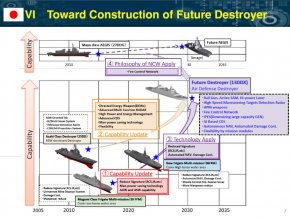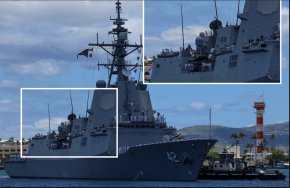I have basic radar knowledge but, from what’s available in the public domain, it appears that the Mogami radar operates in the X band and thus is optimised for short to medium range detection with no long range capability.
It’s disappointing that the Government is insisting on keeping the purchase to existing equipment fit as if they installed the configuration that’s on the Anzacs, the ship would have significantly better surveillance capability.
My radar knowledge is basic as well (I prefer engines), however from my research, and ex WEEO mates, I am aware of the following:
- There are three sensors located on the Mogami mast below the antenna. The top and bottom ones are the NOLQ3E EW system. The middle one is the OPY2 radar.There is, unusually, only one radar on the Mogami.
- The OPY2 is an x band system working in the 8-12 GHz range. It would be capable of detecting sea skimming missiles, and would provide a very high definition local environment. It's what would be typically paired to a NASAMS battery or used to track artillery, for instance. It can have some limitations discerning certain stealth techniques.
- The Mogami doesn't have an s band capability in the 2-4 GHz range, or the L band 1-2 GHz, both optimised for long range monitoring, as would be included in a CEAFAR2 installation.
- It uses AESA gallium nitride componentry, which is the latest technology, so it uses good stuff.
- The OPY 2 is based on the earlier OPY1 and FPS (a multi band radar) systems used on other japanese frigates, and land based air warning setups. So its not a new radar and has a good pedigree.
- Its made by Mitsubishi, who have been making radars since the 60s. They have well regarded ground and aircraft systems, which their naval range draw from.
Advanced systems have multiple different banded radars, mostly to cope with different conditions. Where one radar struggles, another can be more effective.
X band is however a good all rounder for a military application, if you have to choose. A single radar would noticeably keep cost down, which is an important principle with the Mogami.
I will note that the radar is paired to a well regarded optical/IR system with 360 degree coverage(multiple cameras around the ship). This is top shelf and better than on most other platforms. The EW package is pretty good as well, meaning the radar does not need to operate by itself as the only line of defence.
While S and L might be better at longer range detection, as X band can attenuate faster, you can counter this by increasing the energy. The THAAD TYP2 radar (another x band system) for instance is designed to see out upwards of 5,000km. Just don't stand in front of it though as it would fry you.
So, the Mogami, with the single OPY2 radar, is optimised for localised point detection and defence, however it can still use the radar for tracking to at least the horizon (the best any ship can do), and further for higher altitude threats. It's not in the same league as CEAFAR2, but probably more than suitable for its intended role with the Japanese Navy, and most likely our needs too.
The available literature on the new FFM indicates that an updated radar will be utilised for the revised platform, but no details have been provided. Models of the new FFM do however show a second radar panel on the mast, so expect perhaps an s band inclusion for improved AAW capability.





